Todwick Environment: Wild Birds
SK58 Birders – December 2012
by Brian Chambers
The November 2012 meeting featured a talk and slides by John Linton-Smith. John is a very experienced photographer of wildlife, especially birds at their nesting sites.
There are various Laws and Codes of Practice applicable to bird photography. The number one priority is always the welfare of the bird, the mantra is “the welfare of the bird comes before the photograph”. It is against the law to disturb most bird species whilst they nest build, sit on the nest and when they are raising young.
There are further restrictions for rare species, species listed on Schedule 1 of the Wildlife & Countryside Act, such as Golden Eagle, Hen Harrier, Osprey and many others. To photograph these species requires a special licence and this will only be issued to persons who can demonstrate a good knowledge of Natural History and Photography, licences are not awarded without very careful consideration.
John of course has such a licence and with the use of Bird Hides has produced some wonderful photos. The Hides have to be carefully established over many days so as not to disturb or alert the target species, then it is a case of sitting in the hide, all day perhaps, taking hundreds of shots just hoping to catch the perfect pose.
He showed us birds from the Southerland region of Scotland, including Hen Harrier, Golden Eagle, Short-eared Owl, Buzzard, Skylark and many others. An Excellent Evening!
Locally we birders are on the lookout for Waxwings within the SK58 area. This could be a bumper year for this charismatic, glamorous species. A Starling sized bird of pinkish hue with a large crest on the crown, also with yellow showing on the wings and tail whilst perched. They are often in large flocks, feeding on berries. They are prolific berry eaters, it has been estimated that they can consume 500 – 1000 per day, this amounts to twice their body weight.
These Irruptions occur every 5 – 10 years and are linked with good breeding years and lack of berries in their normal northern habitats, thus making the birds travel further south to find suitable feeding sites.
Locally they have often favoured the berry trees in Woodsetts, so far just 5 birds have been seen here. Traditionally they favour big supermarket car parks – planted with Rowans but there isn’t much of this habitat in SK58.
Update: 14 Waxwings were seen in the gardens along Gildingwells Road at Woodsetts on Thursday, 13 December 2012. They are quite unfazed by people, they just roost in a tree nearby with sallies down to collect berries, here cotoneaster is just a few yards away.
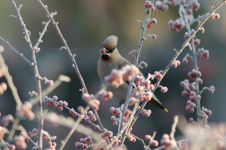
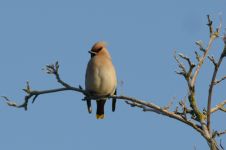
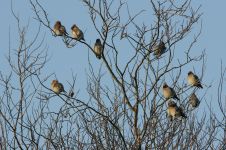
Click the images to see larger versions
SK58 Birders – November 2012
by Brian Chambers
SK58 Birders meetings and field trips are back in action after the summer break. Meetings are now held at Anston Parish Hall, still on the last Wednesday of the month starting at 7.30 pm, everybody is welcome especially non-members.
September 2012 had a talk based on Bhutan, October 2012 featured a talk by our Recorder, Andy Hirst, taking a nostalgic look back on 20 years of SK58 Birding – this is our 20th anniversary year. November features a talk by a regular visitor to our meetings – John Linton Smith, he has some Scotland birds to share, hopefully this Newsletter will reach you in time; the meeting is on the 28 November 2012.
The SK58 site locally is the fields across to South Anston – Axle Lane, it may look unattractive to birds with the lack of hedges, trees and open cultivation but birds do find food here.
Skylark are present throughout the year, mainly using the tractor tramlines as a breeding site. Post breeding flocks can be large, this includes locally migrating birds, counts in excess of 150 Skylark have been recorded occasionally.
Meadow Pipit is another species that can be present in numbers. This LBJ (birding vernacular for Little Brown Job) is more handsome than at first sight – it has a pleasantly streaked buffy coloured breast and a prominent white eye ring.
Linnet flocks are generally present, possibly upwards of 100 birds. They do prefer to forage in the stubble so once the winter sowing has occurred they tend to disappear. This autumn a Twite was located amongst the flock, this is the moorland breeding species which usually make their way to Winter on the coastal salt-marsh.
Gulls are autumn visitors especially when ploughing is in progress, huge flocks of Black-headed Gulls (now minus the black head) and Lesser Black-backed Gulls being the main species. A Yellow-legged Gull was recorded in September, this is a species closely related to Herring Gull (noisy seaside rooftop gull) common further south in the Mediterranean region. But it is becoming more common, as its name says is mainly recognized by leg colour.
Fieldfare and Redwing, the Winter Thrushes from the Scandinavian region are now present.
Raptors seen over the Axle Lane fields include Kestrel, Sparrowhawk and the ever more numerous Buzzard. Merlin, the UK’s smallest bird of prey, has also been present, attracted by the Skylark and Linnet prey species. Peregrine Falcon is also an occasional visitor, these hunt larger prey in the form of Woodpigeon and Golden Plover. Golden Plover numbers have plummeted in recent years, gone are the days of 3–4,000 flocks, now a count of 50–100 is somewhat unusual.
There is no meeting in December 2012. The next meeting is the AGM on 30 January 2013.
SK58 Birders – June 2012
by Brian Chambers
The May SK58 Birders meeting featured a talk by Mike Richardson, illustrated with some top-quality slides of Mexican birdlife. Birding in the south of the country, security wasn’t a problem, the people friendly and helpful. This was our last meeting at the “Loyal Trooper”; in future we will use the Anston Parish Hall, meetings will continue to be held on the last Wednesday of the month starting at 7.30 pm.
Locally, Yellow Wagtails are present in good numbers amongst the rape seed crops on Axle Lane, at least 10 birds. This is the summer migrant Wagtail, the male a bright canary yellow, not to be confused with the resident Grey Wagtail which also has yellow on its breast but a grey back. Also present in the same crops are Reed Bunting, the male with a black head separated from its back by a broad white collar, the female a much browner bird.
A few Corn Bunting are still surviving near the stone wall, generally at the Anston end. Nationally numbers of this species have declined alarmingly, unfortunately this pattern is also true of Axle Lane, only ten years ago there would be at least 5 pairs; now one or possibly two pairs is all that can be expected.
Axle Lane also had some rare Raptor Birds flying through last month. A female Marsh Harrier was recorded on the 9th, these birds are well established now after numbers plummeted nationally to single figures, but reintroduction & conservation of reedbed habitat has led to a great environmental success. A Red Kite was also spotted midmonth, another similar successful reintroduction story.
The third unusual raptor was a Hobby, also seen midmonth. These are summer migrant birds somewhat similar in outline to Swifts but larger and with red below the tail. They hawk for dragonfly, i.e. catch on the wing, so are often seen close to water. Their other food source is House Martin and Swallow, usually immature birds beaten for speed and manoeuvring by the superb flying skills of the Hobby. Hobby are gradually extending their range northwards, so are likely to be seen more often around our area.
The next meeting will be at Anston Parish Hall on 27 June 2012. Rebecca Clay will give a talk entitled “Dragonfly Topic”. As in previous years, no meetings are held in July or August, the next meeting is 26 September 2012 when regular SK58 Speaker, Paul Hobson, will give a talk “Bhutan – Land of the Thunder Dragon.” Make it a Date!
SK58 Birders – April 2012
by Brian Chambers
The March 2012 indoor meeting at the Loyal Trooper included an analysis of SK58 Birders records, collected over the past 20 years. Every two years a survey of the 10 kilometre square is undertaken, this year is a survey year. The Square is divided into 25 sections called Tetrads, each Tetrad is visited twice between April and July and the birds seen, over a one hour period, are recorded. The data reveals some interesting trends, generally matching National trends of the status of our common bird species.
This is the group’s 20th year, during this time over 130,000 records have been collected, one record being the number of a given species seen at a particular location. This huge database, all on computer, is a valued source of information. It has proved very useful during a number of planning applications where an environmental species assessment is required. We can give ourselves a “big pat on the back” for helping to conserve a few good bits of the local environment – a constant ever threatening battle.
A number of locals have reported sightings of large birds circling overhead recently. These are Buzzards, large brown birds of prey. They have had an astonishing increase in recent years, one of our members recorded 64 birds in the SK58 Square one day in March and he didn’t visit 2 locations where Buzzards are known to be common. 15 years ago they used to be restricted to the western half of the country, but now are widespread and probably the commonest UK Raptor, certainly much more numerous than either Kestrel or Sparrowhawk in our area.
If you like to look at Owls then a dusk-time visit to Kiveton Woodlands could be rewarded with a sight of a Short-eared Owl. One and sometimes two have been recorded quartering the grassy areas of the old colliery spoil heap. This species fly slowly over the ground on light brown long wings in its search for rodent prey, the typical disc owl face makes the species unmistakeable.
The April Meeting is on Wednesday the 25th, it features a talk and slideshow by Mike Vickers entitled “Trinidad & Tobago”.
The May meeting is on the 30th when Mike Richardson will recount his birding trip “From Mexborough to Mexico”.
Both meetings are held at the Loyal Trooper, South Anston, starting at 7.30 pm, new members are most welcome. If you are interested in birdlife why not give us a go?
SK58 Birders – March 2012
by Brian Chambers
The generally mild weather and the amazing sunny day on Sunday, 11th March 2012 has got the birds singing, pairing up and nest building. March also sees the return of the first migrant birds.
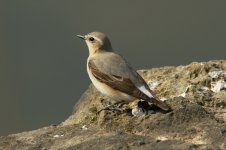
Click the image to see larger version
Usually the first arrival on Axle Lane is the Wheatear. Its preferred site is to perch on the old stone-wall and to drop down into the fields in search of some tasty insect morsel. The most striking feature is a bold white rump, easily picked out as it makes short flights along the wall or over the field. The male is a handsome bird with a bold black eye stripe with a white line above, grey back and a pinky-buff chest. The female is also a fine looker, but browner. Often there may be a number of birds, if so then they will all be in the same area.
Sand Martins are the first of the Hirundine class of birds to arrive – others House Martin and Swallow. They are seen over Axle Lane, particularly being attracted to lakes and ponds over which they search in flight for insect prey. Locally they can be seen nesting in the sandstone quarry face at Brown Bayley’s pond at Fox Covert, in past years 30+ pairs. They are the smallest of the three species, brown overall with a pale chest, some should be around mid month.
House Martins have a white rump and together with the familiar Swallows can be seen around the farm buildings at the end of Axle Lane, they will arrive later but should be here before the end of the month.
Yellow Wagtails are another regular summer migrant species to breed on the Axle Lane fields. They will generally appear mid-April, the bright yellow colouring being unmistakeable. They will often perch on the wall or atop a yellow rapeseed plant calling to attract a mate or marking their territory.
So, that’s a few birds to look out for locally, the call of the Cuckoo should also be heard about mid-month, but numbers have been on the decline in recent years.
The SK58 Birders April meeting features a talk on the bird-life of Trinidad & Tobago. As usual this will be held at the “Loyal Trooper” pub, South Anston on the last Wednesday of the month – the 25th, starting at 7.30 pm.
SK58 Birders – February 2012
by Brian Chambers
The SK58 Birders next meeting is on Wednesday, 29 February 2012 at the “Loyal Trooper”, South Anston. John Gardner will give a talk and slides on European Birds.
The March meeting will be on the 28 March 2012, Rob Hardcastle will analyse the thousands of records returned over the past 2 years from within SK58 and try to make some sense out of them – population trends, species decline/fall.
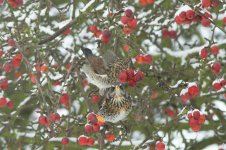
Click the image to see larger version
The severe cold spell should have brought a few extra birds to feed in the Gardens, it certainly did to ours. We had a peak of c. 150 Fieldfare feeding on a bumper crop of crab apples.
The extra bird numbers also brings in their hunters. Sparrowhawks are not everybody’s favourite species but they are fascinating to watch. The first sign of a presence is when all the birds scatter, in their panic sometimes colliding with the house windows. The Sparrowhawk will speed through and often chase a small bird into a hedge or bush, despite the speed of entry they somehow manage to emerge with all feathers intact and often with the prey. The female bird is larger, as with most raptors, with a brown back; the male has a slate blue back and a splendid rufous brown chest.
Kestrel are probably more often seen due to their hovering behaviour. Their food is more usually voles, mice and insects but they will take small birds if the opportunity arises. Numbers are on the decline, mainly due to less suitable hunting territory, this is field margins and road-side verges. It is still common to see them hovering over the Motorway verges, this habitat is now one of their strongholds.
Sparrowhawk are much more common in my garden than Kestrel. I did have a Buzzard perch in a Silver Birch tree at the bottom of the garden last week; this was a new species to add to my Garden List! Only a few years ago Buzzard was a rare species in SK58, only seen in the Firbeck area near the Earl Scarborough Estate. Now they can be seen throughout and often overhead in Todwick. This is a national trend, previously Buzzard was a species mainly confined to the west of the country but not now, is it due to the recovery in the Rabbit population?
This time of year is good for Gulls. Black-headed are the commonest species, now just acquiring their black (really brown) heads. Then there are Lesser Black-backed Gulls, the larger Great-Black-backed Gulls, the not so common Common Gulls and a few Herring Gulls (the Gull of seaside rooftops). Gulls are not everybody’s cup of tea – they all look similar, but if you are up for a challenge then sorting Gull species should keep you occupied! All these species, adult and immature, pass over Axle Lane at some time or other.
SK58 Birders – January 2012
by Brian Chambers
About 600 Golden Plover are over-wintering on the Axle Lane fields, a much lower count than in previous years. A Peregrine Falcon is frequenting the site and unsettling the birds. During the day the birds form a close flock as they rest on the ground, low flying flocks whirl around as they come to join the roost. If a threat persists then the flock can soar away and be almost lost high in the sky. They are mainly night feeding birds, searching out the worms and insects; if you look closely white droppings can be seen all over the field.
There are many Fieldfare and Redwing around, if your garden supports berries or crab apples then there is a good chance that these Winter Thrushes will pay a visit. The Fieldfare is a stocky bird with grey head and rump and much spotting on the orangey breast, in flight they make a distinctive schack-schack call. The Redwing is a little smaller, more Song Thrush size, it supports a very noticeable white stripe above the eye and of course red on the flanks and on the underwing. These are two handsome species that will add a bit of glamour to any garden.
Another handsome species is the Bullfinch. The male is especially so, with its black head and bright pinkish-red chest. Locally, small flocks of 5–6 birds can be seen along the Chesterfield Canal, the stretch from Kiveton Station to Tommy Flockton’s Meadow is a reliable location.
The old Kiveton Pit site is becoming well established as a Nature Reserve. The Forestry Commission have planted many trees including many Alder and Silver Birch, both a favourite food source for Siskin and Redpoll. These birds together with Goldfinch can form sizable flocks, 150–200, as they feed on the seeds. Both Siskin and Redpoll breed in the UK, mainly further north in the coniferous woodlands. In Winter the numbers are boosted by an influx of birds from Northern Europe so making it much easier to locate them, hence their presence at Kiveton and also along the Chesterfield Canal.
The car park at Kiveton Woodlands is an ideal starting point to walk both the Park and along Tommy Flockton’s Marsh towards the Chesterfield Canal. All these sites should contain some attractive birds.
The next meeting of SK58 is on Wednesday, 25 January 2012 at the Loyal Trooper, South Anston. It will feature a talk by SK58 member Chris Lilley on the subject of Bird Ringing.
Continue to 2011 reports.
